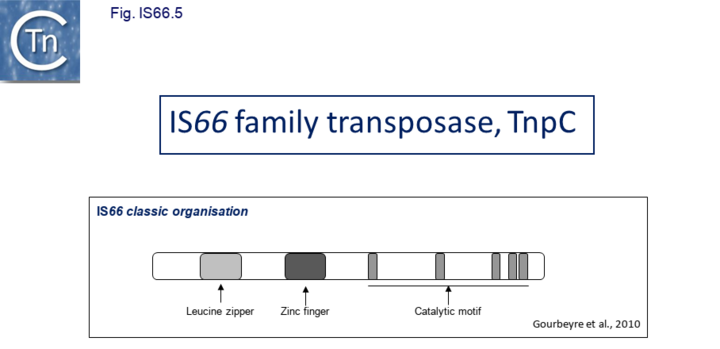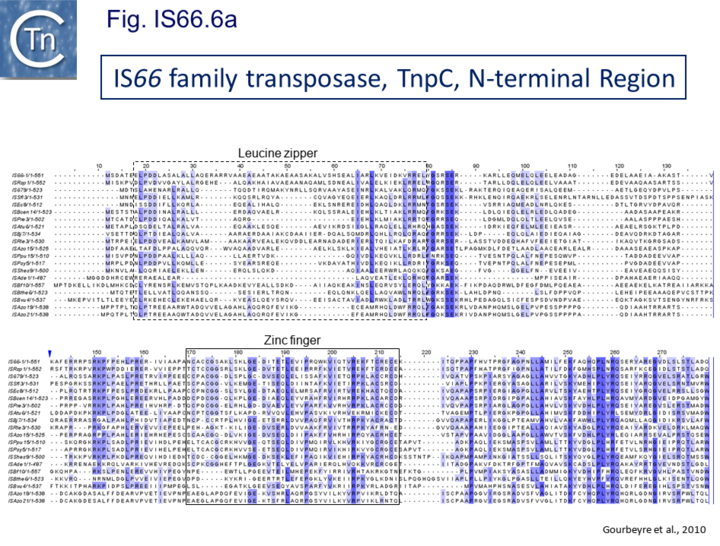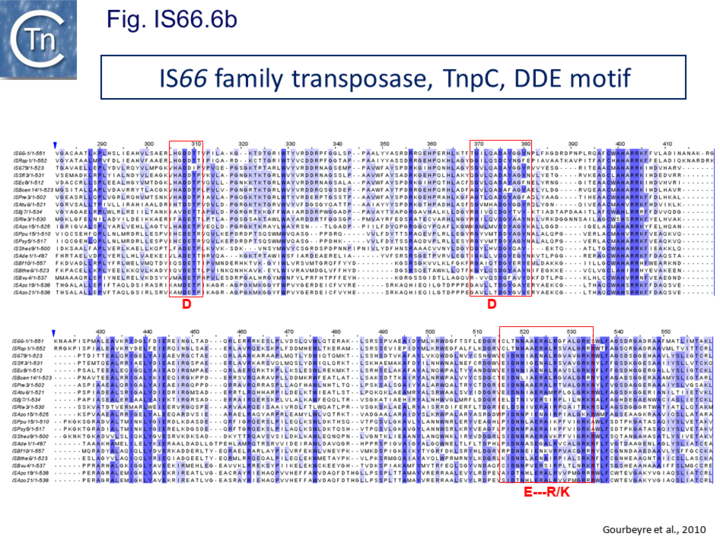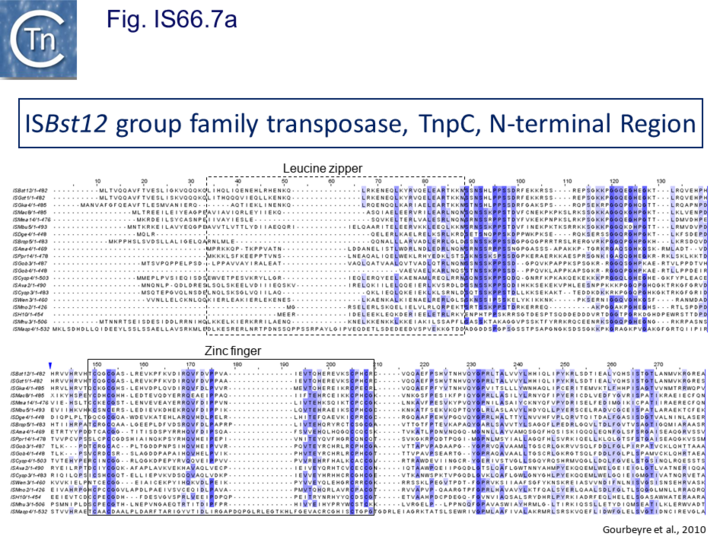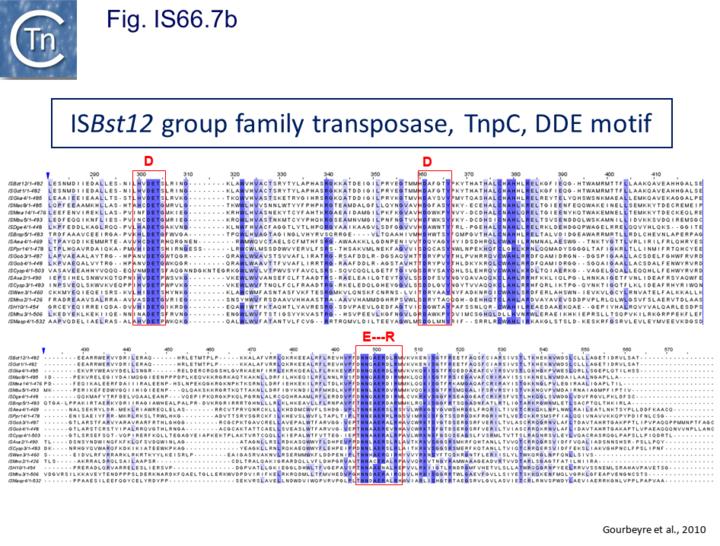Difference between revisions of "IS Families/IS66 family"
| Line 1: | Line 1: | ||
====General==== | ====General==== | ||
| − | IS''66'' was first identified in the Ti plasmid pTi66 of ''[[wikipedia:Agrobacterium_tumefaciens|Agrobacterium tumefaciens]]'' Sciaky<ref><nowiki><pubmed>6095299</pubmed></nowiki></ref><ref><nowiki><pubmed>6366736</pubmed></nowiki></ref> and, soon after in the symbiotic plasmid, pSym, of ''[[wikipedia:Sinorhizobium_fredii|Rhizobium fredii]]''<ref><nowiki><pubmed>24302303</pubmed></nowiki></ref>. The vast majority of IS''66'' members originate from the [[wikipedia:Proteobacteria|Proteobacteria]] with several from the [[wikipedia:Bacteroidetes|Bacteroidetes]]/[[wikipedia:Green_sulfur_bacteria|Chlorobi]] and the [[wikipedia:Firmicutes|Firmicutes]]. A second group of closely related ISs, widely spread among both bacteria and [[wikipedia:Archaea|archaea]] are thought to represent a sub-group within the IS''66'' family<ref name=":0"><pubmed>20079432</pubmed> | + | IS''66'' was first identified in the Ti plasmid pTi66 of ''[[wikipedia:Agrobacterium_tumefaciens|Agrobacterium tumefaciens]]'' Sciaky<ref><nowiki><pubmed>6095299</pubmed></nowiki></ref><ref><nowiki><pubmed>6366736</pubmed></nowiki></ref> and, soon after in the symbiotic plasmid, pSym, of ''[[wikipedia:Sinorhizobium_fredii|Rhizobium fredii]]''<ref><nowiki><pubmed>24302303</pubmed></nowiki></ref>. The vast majority of [https://tncentral.ncc.unesp.br/ISfinder/scripts/ficheIS.php?name=IS66 IS''66''] members originate from the [[wikipedia:Proteobacteria|Proteobacteria]] with several from the [[wikipedia:Bacteroidetes|Bacteroidetes]]/[[wikipedia:Green_sulfur_bacteria|Chlorobi]] and the [[wikipedia:Firmicutes|Firmicutes]]. A second group of closely related ISs, widely spread among both bacteria and [[wikipedia:Archaea|archaea]] are thought to represent a sub-group within the [https://tncentral.ncc.unesp.br/ISfinder/scripts/ficheIS.php?name=IS66 IS''66''] family<ref name=":0"><pubmed>20079432</pubmed> |
| − | + | ||
| − | + | </nowiki></ref>. | |
| + | |||
| + | These are relatively well distributed ([[:File:Fig IS66.1.png|Fig. IS66.1]]). The founder member, [https://tncentral.ncc.unesp.br/ISfinder/scripts/ficheIS.php?name=ISBst12 IS''Bst12''], originally isolated from ''[[wikipedia:Geobacillus_stearothermophilus|Bacillus stearothermophilus]]'', was described as a novel family<ref name=":1"><pubmed>10974105</pubmed> | ||
| + | |||
| + | </nowiki></ref>, but identification of many additional examples suggests that the [https://tncentral.ncc.unesp.br/ISfinder/scripts/ficheIS.php?name=ISBst12 IS''Bst12''] and [https://tncentral.ncc.unesp.br/ISfinder/scripts/ficheIS.php?name=IS66 IS''66''] groups should be considered a single family ([[:File:Fig IS66.2.png|Fig. IS66.2]]). Several examples of IS derivatives with passenger genes have been identified ([[:File:Fig IS66.3.png|Fig. IS66.3]]; [[IS Families/IS66 family#A list of representative IS66 family members and the ISBst12 group|Table IS66.1]]). One important example is a potential tIS in which '''IRL''' is located downstream from an MCR-3 ([[wikipedia:Colistin|colistin resistance gene]]) <ref><nowiki><pubmed>29712655</pubmed></nowiki></ref>. Members of the [https://tncentral.ncc.unesp.br/ISfinder/scripts/ficheIS.php?name=ISBst12 IS''Bst12''] group are found in [[wikipedia:Actinobacteria|Actinobacteria]], [[wikipedia:Cyanobacteria|Cyanobacteria]], ''[[wikipedia:Deinococcus|Deinococcus]]''/''[[wikipedia:Thermus|Thermus]]'', [[wikipedia:Firmicutes|Firmicutes]], and [[wikipedia:Planctomycetes|Planctomycetes]] as well as in [[wikipedia:Proteobacteria|Proteobacteria]]. They are also found in the https://en.wikipedia.org/wiki/Euryarchaeota phylum of [[wikipedia:Archaea|archaea]] (but have not yet been identified in the [[wikipedia:Crenarchaeota|Crenarchaeota]]). | ||
<br /> | <br /> | ||
| − | [[File:Fig IS66. | + | [[File:Fig IS66.1.png|center|thumb|720x720px|'''Fig IS66.1.''' Distance tree computed by neighbor-joining, using the JTT matrix-based<ref><nowiki><pubmed>1633570</pubmed></nowiki></ref> with gamma-distribution and bootstrap of 500 replicates. The results are visualized with [https://code.google.com/archive/p/treeviewx/ TreeView]<ref><nowiki><pubmed>18792942</pubmed></nowiki></ref>. Pink boxes indicate Firmicutes, blue boxes indicate Bacteroidetes/Chlorobi, and green boxes with white characters indicate Archaeal hosts. |alt=]] |
<br /> | <br /> | ||
| − | [[File:Fig IS66. | + | [[File:Fig IS66.2.png|center|thumb|450x450px|'''Fig IS66.2.''' Each circle represents an individual IS transposase (TnpC) amino acid sequence. '''Left)''' Inflation factor of 1.2, score >60 (links with scores of less than 60 were removed). These values should indicate the division between families, but show that the IS''66'' and [https://tncentral.ncc.unesp.br/ISfinder/scripts/ficheIS.php?name=ISBst12 IS''Bst12''] groups belong to the same family. '''Right)''' Inflation factor of 2, score >60. These settings define IS groups (Siguier et al., 2009) which are automatically assigned different colors. ]] |
<br /> | <br /> | ||
| − | + | [[File:Fig IS66.3.png|center|thumb|720x720px|'''Fig IS66.3.''' Organization of different classical [https://tncentral.ncc.unesp.br/ISfinder/scripts/ficheIS.php?name=IS66 IS''66''] family members and of the [https://tncentral.ncc.unesp.br/ISfinder/scripts/ficheIS.php?name=ISBst12 IS''Bst12''] group. The IS is represented as a rectangle with flanking '''D'''irect '''R'''epeats (DR) in red and terminal inverted repeats in blue (triangles). The orfs are shown in red (''tnpA''), orange (''tnpB''), dark blue (the transposase, ''tnpC''), and green (passenger genes, P). The length of each orf is indicated in base pairs, together with the total length of the example IS. '''From top to bottom''': IS''679'') The "classic" IS''66'' organization. [https://tncentral.ncc.unesp.br/ISfinder/scripts/ficheIS.php?name=ISBf10 tIS''Bf10''], an IS''66'' with associated passenger genes. To denote these special cases and underline their close relationship to classic ISs, we refer to them as ‘‘tIS’’ signifying the presence of '''''transposable passenger genes'''''. [https://tncentral.ncc.unesp.br/ISfinder/scripts/ficheIS.php?name=ISPpu15 IS''Ppu15'']) IS''66'' variants lacking ''tnpA''. [https://tncentral.ncc.unesp.br/ISfinder/scripts/ficheIS.php?name=ISBst12 IS''Bst12'']) carrying the single orf equivalent to ''tnpC'' of IS''66''. [https://tncentral.ncc.unesp.br/ISfinder/scripts/ficheIS.php?name=ISMasp4 tIS''Masp4'']) [https://tncentral.ncc.unesp.br/ISfinder/scripts/ficheIS.php?name=ISBst12 IS''Bst12''] with passenger genes (tIS).|alt=]] | |
====Genome Impact==== | ====Genome Impact==== | ||
Members of this family are involved in insertional gene inactivation (e.g. inactivation of the [https://jb.asm.org/content/191/9/2973 ''liaFSR'' operon] leading to hypersensitivity to [[wikipedia:Daptomycin|daptomycin]]<ref><nowiki><pubmed>27353469</pubmed></nowiki></ref>; loss of loss of S-layer-gene expression in ''[[wikipedia:Geobacillus_stearothermophilus|Bacillus stearothermophilus]] <ref name=":1" />''; gene disruption in the cyanobacterium ''[https://microbewiki.kenyon.edu/index.php/Fremyella_diplosiphon Fremyella duplosiphon]'' involved in regulation of [[wikipedia:Phycoerythrin|phycoerythrin]] synthesis<ref><nowiki><pubmed>21888899</pubmed></nowiki></ref> and in the ''gnaA'' (encoding [[wikipedia:UDP-N-acetylglucosamine_6-dehydrogenase|UDP-N-acetylglucosamine C-6 dehydrogenase]]) of ''[[wikipedia:Acinetobacter_baumannii|Acinetobacter baumannii]]'' leading to changes in the antibacterial resistance profile<ref><nowiki><pubmed>31358579</pubmed></nowiki></ref>). | Members of this family are involved in insertional gene inactivation (e.g. inactivation of the [https://jb.asm.org/content/191/9/2973 ''liaFSR'' operon] leading to hypersensitivity to [[wikipedia:Daptomycin|daptomycin]]<ref><nowiki><pubmed>27353469</pubmed></nowiki></ref>; loss of loss of S-layer-gene expression in ''[[wikipedia:Geobacillus_stearothermophilus|Bacillus stearothermophilus]] <ref name=":1" />''; gene disruption in the cyanobacterium ''[https://microbewiki.kenyon.edu/index.php/Fremyella_diplosiphon Fremyella duplosiphon]'' involved in regulation of [[wikipedia:Phycoerythrin|phycoerythrin]] synthesis<ref><nowiki><pubmed>21888899</pubmed></nowiki></ref> and in the ''gnaA'' (encoding [[wikipedia:UDP-N-acetylglucosamine_6-dehydrogenase|UDP-N-acetylglucosamine C-6 dehydrogenase]]) of ''[[wikipedia:Acinetobacter_baumannii|Acinetobacter baumannii]]'' leading to changes in the antibacterial resistance profile<ref><nowiki><pubmed>31358579</pubmed></nowiki></ref>). | ||
| − | It has also been shown (using RACE) that IS''66'' insertion can create hybrid promoters<ref><nowiki><pubmed>29374029</pubmed></nowiki></ref>. | + | It has also been shown (using RACE) that [https://tncentral.ncc.unesp.br/ISfinder/scripts/ficheIS.php?name=IS66 IS''66''] insertion can create hybrid promoters<ref><nowiki><pubmed>29374029</pubmed></nowiki></ref>. |
====Organization==== | ====Organization==== | ||
| − | [[File:Fig IS66.4.png|left|thumb| | + | [[File:Fig IS66.4.png|left|thumb|620x620px|'''Fig IS66.4.''' The left ('''IRL''') and right ('''IRR''') inverted terminal repeats are shown in the [https://weblogo.berkeley.edu/ WebLogo format]. They are defined by the direction of transcription of the transposase gene. '''IRL''', by definition, is located on the 5’ side of the transposase orf. |alt=]] |
| − | The IS''66'' reference copy from a plasmid of the enteropathogenic ''[[wikipedia:Escherichia_coli|Escherichia coli]]'' B171, IS''679''<ref name=":2"><pubmed>11418571</pubmed> | + | The [https://tncentral.ncc.unesp.br/ISfinder/scripts/ficheIS.php?name=IS66 IS''66''] reference copy from a plasmid of the enteropathogenic ''[[wikipedia:Escherichia_coli|Escherichia coli]]'' B171, IS''679''<ref name=":2"><pubmed>11418571</pubmed> |
| + | |||
| + | </nowiki></ref> is defined by three ''orfs'' ([[:File:Fig IS66.3.png|Fig. IS66.3]]): ''tnpA'', ''tnpB'' and ''tnp''C and relatively well conserved terminal IR of about 20-30 bp flanked by an 8 bp DR at their insertion sites ([[:File:Fig IS66.4.png|Fig. IS66.4]]). Orf ''tnp''C ([[:File:Fig IS66.5.png|Fig. IS66.5]]) is 1572 bp and its predicted product includes an N-terminal region with potential leucine zipper and zinc finger motifs ([[:File:Fig IS66.5.png|Fig. IS66.5]]; [[:File:Fig IS66.6A.png|Fig. IS66.6a]]; [[:File:Fig IS66.7A.png|Fig. IS66.7a]]) and a typical DDE motif ([[:File:Fig IS66.5.png|Fig. IS66.5]]; [[:File:Fig IS66.6B.png|Fig. IS66.6b]]; [[:File:Fig IS66.7B.png|Fig. IS66.7b]]; outlined in [[:File:IS6.8.png|Fig. IS66.8]]). It also carries an insertion domain between the second '''D''' and the '''E''' of the DDE motif (e.g. [https://tncentral.ncc.unesp.br/ISfinder/scripts/ficheIS.php?name=IS679 IS''679'']'','' [https://tncentral.ncc.unesp.br/ISfinder/scripts/ficheIS.php?name=ISPsy5 IS''Psy5''] ''and'' [https://tncentral.ncc.unesp.br/ISfinder/scripts/ficheIS.php?name=ISMac8 IS''Mac8''])<ref><nowiki><pubmed>20067338</pubmed></nowiki></ref> (see [[:File:1.8.3.png|Fig.7.3]]) ([[General Information/Major Groups are Defined by the Type of Transposase They Use#Transposases examined by secondary structure prediction programs|Table Transposases examined by secondary structure prediction programs]]). | ||
| − | The role of the products of ''tnpA'' (651 bp) and ''tnpB'' (345 bp) is less clear. TnpA carries a potential [[wikipedia:Helix-turn-helix|HTH motif]] (([[:File:Fig IS66.9.png|Fig. IS66.9]]) while TnpB shows no marked potential secondary structure motifs. Mutation of each ''orf'' separately (by introduction of an ''in-frame'' deletion) reduced transposition by at least two orders of magnitude <ref name=":2" />. The three frames are disposed in a pattern suggesting translational coupling: ''tnpB'' is in general in translational reading frame -1 compared to ''tnpA'' and in most cases the termination codon of ''tnpA'' and the initiation codon of ''tnpB'' overlap (ATGA). An initiation codon for ''tnpC'' occurs slightly downstream separated from ''tnpB'' by about 20 bp. | + | The role of the products of ''tnpA'' (651 bp) and ''tnpB'' (345 bp) is less clear. TnpA carries a potential [[wikipedia:Helix-turn-helix|HTH motif]] (([[:File:Fig IS66.9.png|Fig. IS66.9]]) while TnpB shows no marked potential secondary structure motifs. Mutation of each ''orf'' separately (by introduction of an ''in-frame'' deletion) reduced transposition by at least two orders of magnitude <ref name=":2" />. The three frames are disposed in a pattern suggesting translational coupling: ''tnpB'' is in general in translational reading frame -1 compared to ''tnpA'' and in most cases the termination codon of ''tnpA'' and the initiation codon of ''tnpB'' overlap (ATGA). An initiation codon for ''tnpC'' occurs slightly downstream, separated from ''tnpB'' by about 20 bp. |
| − | However, rather surprisingly, in the light of a requirement for all three ''orfs'' for transposition of the canonical IS''66'' family member IS''679'', members of the IS''Bst12'' group are devoid of ''tnpA'' and ''tnpB'' and carry only the ''tnpC'' reading frame. Although both IS''Bst12'' and IS''66'' members contain IRs which start with | + | However, rather surprisingly, in the light of a requirement for all three ''orfs'' for transposition of the canonical IS''66'' family member [https://tncentral.ncc.unesp.br/ISfinder/scripts/ficheIS.php?name=IS679 IS''679''], members of the [https://tncentral.ncc.unesp.br/ISfinder/scripts/ficheIS.php?name=ISBst12 IS''Bst12''] group are devoid of ''tnpA'' and ''tnpB'' and carry only the ''tnpC'' reading frame. Although both [https://tncentral.ncc.unesp.br/ISfinder/scripts/ficheIS.php?name=ISBst12 IS''Bst12''] and IS''66'' members contain IRs which start with 5’ GTAA 3’, they are clearly distinguishable due to a single conserved A at bp 11 In [https://tncentral.ncc.unesp.br/ISfinder/scripts/ficheIS.php?name=ISBst12 IS''Bst12''] which is not conserved in [https://tncentral.ncc.unesp.br/ISfinder/scripts/ficheIS.php?name=IS66 IS''66''] ([[:File:Fig IS66.1.png|Fig. IS66.1]]; [[:File:Fig IS66.4.png|Fig. IS66.4]]). |
| − | IS''66'' members can be grouped into three classes based on their organization: those including all three ''orfs'', A, B and C transcribed in the same direction; those with additional passenger genes invariably present downstream of ''orf''C and transcribed in the same direction; and those which lack ''orf''A but retain both ''orfs'' B and C ([[:File:Fig IS66.1.png|Fig. IS66.1]]; [[:File:Fig IS66.3.png|Fig. IS66.3]]). Each of these organizations includes members with multiple copies, implying that they are active in transposition. In addition to the DDE catalytic domain ([[:File:Fig IS66.5.png|Fig. IS66.5]]; [[:File:Fig IS66.6B.png|Fig. IS66.6b]]; [[:File:Fig IS66.7B.png|Fig. IS66.7b]])<ref name=":0" />, TnpC also exhibits a highly conserved CwAH-rR motif downstream of the second D residue, a relatively conserved CX2(C)X33CX2C motif characteristic of a [[wikipedia:Zinc_finger|zinc finger]] (ZF) further upstream and a leucine-rich region which might form a [[wikipedia:Leucine_zipper|leucine zipper]] (LZ) necessary in multimerisation of other Tpases <ref><nowiki><pubmed>9761671</pubmed></nowiki></ref>, at the N-terminus ([[:File:Fig IS66.5.png|Fig. IS66.5]]; [[:File:Fig IS66.6A.png|Fig. IS66.6a]]; [[:File:Fig IS66.7A.png|Fig. IS66.7a]]). | + | [https://tncentral.ncc.unesp.br/ISfinder/scripts/ficheIS.php?name=IS66 IS''66''] members can be grouped into three classes based on their organization: those including all three ''orfs'', A, B and C transcribed in the same direction; those with additional passenger genes invariably present downstream of ''orf''C and transcribed in the same direction; and those which lack ''orf''A but retain both ''orfs'' B and C ([[:File:Fig IS66.1.png|Fig. IS66.1]]; [[:File:Fig IS66.3.png|Fig. IS66.3]]). Each of these organizations includes members with multiple copies, implying that they are active in transposition. In addition to the DDE catalytic domain ([[:File:Fig IS66.5.png|Fig. IS66.5]]; [[:File:Fig IS66.6B.png|Fig. IS66.6b]]; [[:File:Fig IS66.7B.png|Fig. IS66.7b]])<ref name=":0" />, TnpC also exhibits a highly conserved CwAH-rR motif downstream of the second '''D''' residue, a relatively conserved CX2(C)X33CX2C motif characteristic of a [[wikipedia:Zinc_finger|zinc finger]] (ZF) further upstream and a leucine-rich region which might form a [[wikipedia:Leucine_zipper|leucine zipper]] (LZ) necessary in multimerisation of other Tpases <ref><nowiki><pubmed>9761671</pubmed></nowiki></ref>, at the N-terminus ([[:File:Fig IS66.5.png|Fig. IS66.5]]; [[:File:Fig IS66.6A.png|Fig. IS66.6a]]; [[:File:Fig IS66.7A.png|Fig. IS66.7a]]). |
| − | [[File:Fig IS66.5.png|center|thumb| | + | [[File:Fig IS66.5.png|center|thumb|720x720px|'''Fig IS66.5.''' IS''66'' family tranposase TnpC domain schema. |alt=]] |
| − | [[File:Fig IS66.6A.png|center|thumb| | + | [[File:Fig IS66.6A.png|center|thumb|720x720px|'''Fig IS66.6A.''' TnpC N-terminal region alignment and motifs.|alt=]] |
| − | [[File:Fig IS66.6B.png|center|thumb| | + | [[File:Fig IS66.6B.png|center|thumb|720x720px|'''Fig IS66.6B.''' TnpC DDE motif.|alt=]] |
| − | [[File:Fig IS66.7A.png|center|thumb| | + | [[File:Fig IS66.7A.png|center|thumb|720x720px|'''Fig IS66.7A.''' TnpC N-terminal region alignment and motifs|alt=]] |
| − | [[File:Fig IS66.7B.png|center|thumb| | + | [[File:Fig IS66.7B.png|center|thumb|720x720px|'''Fig IS66.7B.''' TnpC DDE motif from IS''Bst12'' group.|alt=]] |
| − | [[File:IS6.8.png|center|thumb| | + | [[File:IS6.8.png|center|thumb|640x640px|'''Fig IS66.8.''' Conserved active site residues are shown in red. The positions of the IS''679'' residues (top line) are shown between brackets. The numbers between square brackets indicate the distance in amino acids between each sequence block. The upper case indicates fully conserved residues. The Lowercase indicates partial conservation. |alt=]] |
| − | [[File:Fig IS66.9.png|center|thumb| | + | [[File:Fig IS66.9.png|center|thumb|720x720px|'''Fig IS66.9.''' Alignment of TnpA showing the [[wikipedia:Helix-turn-helix|HTH domain]].|alt=]] |
=====A list of representative IS''66'' family members and the IS''Bst12'' group===== | =====A list of representative IS''66'' family members and the IS''Bst12'' group===== | ||
{| class="wikitable" style="margin:auto" | {| class="wikitable" style="margin:auto" | ||
| − | | colspan="11" |'''Table IS66.1.''' A list of representative IS''66'' family members and the IS''Bst12'' group. The table summarises from left to right: the IS name; group defined in the MCL analysis; accession number; host from which it was identified; kingdom (archaea, A, or bacteria, B); phylum; organisation (org) A,B,C,P show the presence of TnpA, TnpB, TnpC and Passenger genes respectively; length of the IS in base pairs (bp); length of the terminal '''I'''nverted '''R'''epeats (IR); length of flanking '''D'''irect '''R'''epeats (DR); number of examples identified in the host genome. | + | | colspan="11" |'''Table IS66.1.''' A list of representative IS''66'' family members and the IS''Bst12'' group. The table summarises from left to right: the IS name; group defined in the [[General Information/IS Identification#IS identification|MCL analysis]]; accession number; host from which it was identified; kingdom (archaea, A, or bacteria, B); phylum; organisation (org) A,B,C,P show the presence of TnpA, TnpB, TnpC and Passenger genes respectively; length of the IS in base pairs (bp); length of the terminal '''I'''nverted '''R'''epeats (IR); length of flanking '''D'''irect '''R'''epeats (DR); number of examples identified in the host genome. |
|- | |- | ||
! scope="col" |IS Name||Group||Accession number||Host||A/B||G+/G-||Org.||L (bp)||IR (bp)||DR (bp)||N° | ! scope="col" |IS Name||Group||Accession number||Host||A/B||G+/G-||Org.||L (bp)||IR (bp)||DR (bp)||N° | ||
|- | |- | ||
| − | |IS''66-1''||—||[https://www.ncbi.nlm.nih.gov/nuccore/AF242881.1/ AF242881]||''[[wikipedia:Agrobacterium_tumefaciens|Agrobacterium tumefaciens]]''||B||G-||ABC||2556||18/20||8||2 | + | |[https://tncentral.ncc.unesp.br/ISfinder/scripts/ficheIS.php?name=IS66 IS''66-1'']||—||[https://www.ncbi.nlm.nih.gov/nuccore/AF242881.1/ AF242881]||''[[wikipedia:Agrobacterium_tumefaciens|Agrobacterium tumefaciens]]''||B||G-||ABC||2556||18/20||8||2 |
|- | |- | ||
| − | |IS''679''||—||[https://www.ncbi.nlm.nih.gov/nuccore/NC_002142 NC_002142]||''[[wikipedia:Escherichia_coli|Escherichia coli]]''||B||G-||ABC||2704||17/25||8||6 | + | |[https://tncentral.ncc.unesp.br/ISfinder/scripts/ficheIS.php?name=IS679 IS''679'']||—||[https://www.ncbi.nlm.nih.gov/nuccore/NC_002142 NC_002142]||''[[wikipedia:Escherichia_coli|Escherichia coli]]''||B||G-||ABC||2704||17/25||8||6 |
|- | |- | ||
| − | |IS''Ade1''||—||[https://www.ncbi.nlm.nih.gov/nuccore/NC_011891 NC_011891]||''[[wikipedia:Anaeromyxobacter_dehalogenans|Anaeromyxobacter dehalogenans]]'' 2CP-1||B||G-||ABC||2957||20/27||8||2 | + | |[https://tncentral.ncc.unesp.br/ISfinder/scripts/ficheIS.php?name=ISAde1 IS''Ade1'']||—||[https://www.ncbi.nlm.nih.gov/nuccore/NC_011891 NC_011891]||''[[wikipedia:Anaeromyxobacter_dehalogenans|Anaeromyxobacter dehalogenans]]'' 2CP-1||B||G-||ABC||2957||20/27||8||2 |
|- | |- | ||
| − | |IS''Atu6''||—||[https://www.ncbi.nlm.nih.gov/nuccore/NC_010929 NC_010929]||''[[wikipedia:Agrobacterium_tumefaciens|Agrobacterium tumefaciens]]''||B||G-||ABCP||2798||23/24||8||3 | + | |[https://tncentral.ncc.unesp.br/ISfinder/scripts/ficheIS.php?name=ISAtu6 IS''Atu6'']||—||[https://www.ncbi.nlm.nih.gov/nuccore/NC_010929 NC_010929]||''[[wikipedia:Agrobacterium_tumefaciens|Agrobacterium tumefaciens]]''||B||G-||ABCP||2798||23/24||8||3 |
|- | |- | ||
| − | |IS''Azo15''||—||[https://www.ncbi.nlm.nih.gov/nuccore/NC_006513 NC_006513]||''[[wikipedia:Azoarcus|Azoarcus]]'' sp. EbN1 or ''Aromatoleum aromaticum'' EbN1||B||G-||ABC||2441||20/21||8||4 | + | |[https://tncentral.ncc.unesp.br/ISfinder/scripts/ficheIS.php?name=ISAzo15 IS''Azo15'']||—||[https://www.ncbi.nlm.nih.gov/nuccore/NC_006513 NC_006513]||''[[wikipedia:Azoarcus|Azoarcus]]'' sp. EbN1 or ''Aromatoleum aromaticum'' EbN1||B||G-||ABC||2441||20/21||8||4 |
|- | |- | ||
| − | |IS''Azo19''||—||[https://www.ncbi.nlm.nih.gov/nuccore/NC_006513 NC_006513]||''[[wikipedia:Azoarcus|Azoarcus]]'' sp. EbN1 or ''Aromatoleum aromaticum'' EbN1||B||G-||ABC||2423||23/26||8||3 | + | |[https://tncentral.ncc.unesp.br/ISfinder/scripts/ficheIS.php?name=ISAzo19 IS''Azo19'']||—||[https://www.ncbi.nlm.nih.gov/nuccore/NC_006513 NC_006513]||''[[wikipedia:Azoarcus|Azoarcus]]'' sp. EbN1 or ''Aromatoleum aromaticum'' EbN1||B||G-||ABC||2423||23/26||8||3 |
|- | |- | ||
| − | |IS''Azo21''||—||[https://www.ncbi.nlm.nih.gov/nuccore/NC_006513 NC_006513]||''[[wikipedia:Azoarcus|Azoarcus]]'' sp. EbN1 or ''Aromatoleum aromaticum'' EbN1||B||G-||ABC||2423||23/26||8||2 | + | |[https://tncentral.ncc.unesp.br/ISfinder/scripts/ficheIS.php?name=ISAzo21 IS''Azo21'']||—||[https://www.ncbi.nlm.nih.gov/nuccore/NC_006513 NC_006513]||''[[wikipedia:Azoarcus|Azoarcus]]'' sp. EbN1 or ''Aromatoleum aromaticum'' EbN1||B||G-||ABC||2423||23/26||8||2 |
|- | |- | ||
| − | |IS''Bcen14''||—||[https://www.ncbi.nlm.nih.gov/nuccore/NC_011001 NC_011001]||''[[wikipedia:Burkholderia_cenocepacia|Burkholderia cenocepacia]]'' J2315||B||G-||ABC||2516||18/22||8||4 | + | |[https://tncentral.ncc.unesp.br/ISfinder/scripts/ficheIS.php?name=ISBcen14 IS''Bcen14'']||—||[https://www.ncbi.nlm.nih.gov/nuccore/NC_011001 NC_011001]||''[[wikipedia:Burkholderia_cenocepacia|Burkholderia cenocepacia]]'' J2315||B||G-||ABC||2516||18/22||8||4 |
|- | |- | ||
| − | |IS''Bf10''||—||[https://www.ncbi.nlm.nih.gov/nuccore/NC_006347 NC_006347]||''[[wikipedia:Bacteroides_fragilis|Bacteroides fragilis]]'' YCH46||B||G-||ABCP||2939||20/21||8||4 | + | |[https://tncentral.ncc.unesp.br/ISfinder/scripts/ficheIS.php?name=ISBf10 IS''Bf10'']||—||[https://www.ncbi.nlm.nih.gov/nuccore/NC_006347 NC_006347]||''[[wikipedia:Bacteroides_fragilis|Bacteroides fragilis]]'' YCH46||B||G-||ABCP||2939||20/21||8||4 |
|- | |- | ||
| − | |IS''Bj7''||—||[https://www.ncbi.nlm.nih.gov/nuccore/NC_004463 NC_004463]||''[[wikipedia:Bradyrhizobium_japonicum|Bradyrhizobium japonicum]]'' USDA 110||B||G-||ABC||2865||40/50||8||2 | + | |[https://tncentral.ncc.unesp.br/ISfinder/scripts/ficheIS.php?name=ISBj7 IS''Bj7'']||—||[https://www.ncbi.nlm.nih.gov/nuccore/NC_004463 NC_004463]||''[[wikipedia:Bradyrhizobium_japonicum|Bradyrhizobium japonicum]]'' USDA 110||B||G-||ABC||2865||40/50||8||2 |
|- | |- | ||
| − | |IS''Bthe6''||—||[https://www.ncbi.nlm.nih.gov/nuccore/NC_004663 NC_004663]||''[[wikipedia:Bacteroides_thetaiotaomicron|Bacteroides thetaiotaomicron]]''||B||G-||ABC||2544||24||8||2 | + | |[https://tncentral.ncc.unesp.br/ISfinder/scripts/ficheIS.php?name=ISBthe6 IS''Bthe6'']||—||[https://www.ncbi.nlm.nih.gov/nuccore/NC_004663 NC_004663]||''[[wikipedia:Bacteroides_thetaiotaomicron|Bacteroides thetaiotaomicron]]''||B||G-||ABC||2544||24||8||2 |
|- | |- | ||
| − | |IS''Bvu4''||—||[https://www.ncbi.nlm.nih.gov/nuccore/NC_009614 NC_009614]||''[[wikipedia:Bacteroides|Bacteroides vulgatus]]'' ATCC 8482||B||G-||BC||2371||30/32||8||5 | + | |[https://tncentral.ncc.unesp.br/ISfinder/scripts/ficheIS.php?name=ISBvu4 IS''Bvu4'']||—||[https://www.ncbi.nlm.nih.gov/nuccore/NC_009614 NC_009614]||''[[wikipedia:Bacteroides|Bacteroides vulgatus]]'' ATCC 8482||B||G-||BC||2371||30/32||8||5 |
|- | |- | ||
| − | |IS''Ec8''||—||[https://www.ncbi.nlm.nih.gov/nuccore/NC_004431 NC_004431]||''[[wikipedia:Escherichia_coli|Escherichia coli]]'' CFT073||B||G-||ABC||2442||18/22||8||7 | + | |[https://tncentral.ncc.unesp.br/ISfinder/scripts/ficheIS.php?name=ISEc8 IS''Ec8'']||—||[https://www.ncbi.nlm.nih.gov/nuccore/NC_004431 NC_004431]||''[[wikipedia:Escherichia_coli|Escherichia coli]]'' CFT073||B||G-||ABC||2442||18/22||8||7 |
|- | |- | ||
| − | |IS''Ppu15''||—||[https://www.ncbi.nlm.nih.gov/nuccore/NC_002947 NC_002947]||''[[wikipedia:Pseudomonas_putida|Pseudomonas putida]]'' KT2440||B||G-||BC||2041||22/28||8||4 | + | |[https://tncentral.ncc.unesp.br/ISfinder/scripts/ficheIS.php?name=ISPpu15 IS''Ppu15'']||—||[https://www.ncbi.nlm.nih.gov/nuccore/NC_002947 NC_002947]||''[[wikipedia:Pseudomonas_putida|Pseudomonas putida]]'' KT2440||B||G-||BC||2041||22/28||8||4 |
|- | |- | ||
| − | |IS''Pre3''||—||[https://www.ncbi.nlm.nih.gov/nuccore/NC_004444 NC_004444]||''[[wikipedia:Pseudomonas_resinovorans|Pseudomonas resinovorans]]''||B||G-||ABCP||2957||17/24||8||2 | + | |[https://tncentral.ncc.unesp.br/ISfinder/scripts/ficheIS.php?name=ISPre3 IS''Pre3'']||—||[https://www.ncbi.nlm.nih.gov/nuccore/NC_004444 NC_004444]||''[[wikipedia:Pseudomonas_resinovorans|Pseudomonas resinovorans]]''||B||G-||ABCP||2957||17/24||8||2 |
|- | |- | ||
| − | |IS''Psy5''||—||[https://www.ncbi.nlm.nih.gov/nuccore/AE016853 AE016853]||[[wikipedia:Pseudomonas_syringae|''Pseudomonas syringae'' pv. ''tomato'']] str. DC3000||B||G-||BC||2059||21/28||8||33 | + | |[https://tncentral.ncc.unesp.br/ISfinder/scripts/ficheIS.php?name=ISPsy5 IS''Psy5'']||—||[https://www.ncbi.nlm.nih.gov/nuccore/AE016853 AE016853]||[[wikipedia:Pseudomonas_syringae|''Pseudomonas syringae'' pv. ''tomato'']] str. DC3000||B||G-||BC||2059||21/28||8||33 |
|- | |- | ||
| − | |IS''Rle3''||—||[https://www.ncbi.nlm.nih.gov/nuccore/NC_008382 NC_008382]||''[[wikipedia:Rhizobium_leguminosarum|Rhizobium leguminosarum]]'' bv. ''viciae'' 3841||B||G-||ABC||2500||14/15||8||2 | + | |[https://tncentral.ncc.unesp.br/ISfinder/scripts/ficheIS.php?name=ISRle3 IS''Rle3'']||—||[https://www.ncbi.nlm.nih.gov/nuccore/NC_008382 NC_008382]||''[[wikipedia:Rhizobium_leguminosarum|Rhizobium leguminosarum]]'' bv. ''viciae'' 3841||B||G-||ABC||2500||14/15||8||2 |
|- | |- | ||
| − | |IS''Rsp1''||—||[https://www.ncbi.nlm.nih.gov/nuccore/U00090 U00090]||''[[wikipedia:Rhizobium|Rhizobium]]'' sp. NGR234||B||G-||ABCP||3481||17/22||8||2 | + | |[https://tncentral.ncc.unesp.br/ISfinder/scripts/ficheIS.php?name=ISRsp1 IS''Rsp1'']||—||[https://www.ncbi.nlm.nih.gov/nuccore/U00090 U00090]||''[[wikipedia:Rhizobium|Rhizobium]]'' sp. NGR234||B||G-||ABCP||3481||17/22||8||2 |
|- | |- | ||
| − | |IS''Sfl3''||—||[https://www.ncbi.nlm.nih.gov/nuccore/AL391753 AL391753]||''[[wikipedia:Shigella_flexneri|Shigella flexneri]]''||B||G-||ABC||2729||11||0||2 | + | |[https://tncentral.ncc.unesp.br/ISfinder/scripts/ficheIS.php?name=ISSfl3 IS''Sfl3'']||—||[https://www.ncbi.nlm.nih.gov/nuccore/AL391753 AL391753]||''[[wikipedia:Shigella_flexneri|Shigella flexneri]]''||B||G-||ABC||2729||11||0||2 |
|- | |- | ||
| − | |IS''Shes9''||—||[https://www.ncbi.nlm.nih.gov/nuccore/NC_008750 NC_008750]||''[[wikipedia:Shewanella|Shewanella]]'' sp. W3-18-1||B||G-||ABC||2370||18/24||8||3 | + | |[https://tncentral.ncc.unesp.br/ISfinder/scripts/ficheIS.php?name=ISShes9 IS''Shes9'']||—||[https://www.ncbi.nlm.nih.gov/nuccore/NC_008750 NC_008750]||''[[wikipedia:Shewanella|Shewanella]]'' sp. W3-18-1||B||G-||ABC||2370||18/24||8||3 |
|- | |- | ||
| − | |IS''Ama4''||IS''Bst12''||[https://www.ncbi.nlm.nih.gov/nuccore/NC_011138 NC_011138]||''[[wikipedia:Alteromonas_macleodii|Alteromonas macleodii]]'' 'Deep ecotype'||B||G-||C||1529||28/29||9||3 | + | |[https://tncentral.ncc.unesp.br/ISfinder/scripts/ficheIS.php?name=ISAma4 IS''Ama4'']||IS''Bst12''||[https://www.ncbi.nlm.nih.gov/nuccore/NC_011138 NC_011138]||''[[wikipedia:Alteromonas_macleodii|Alteromonas macleodii]]'' 'Deep ecotype'||B||G-||C||1529||28/29||9||3 |
|- | |- | ||
| − | |IS''Ava2''||IS''Bst12''||[https://www.ncbi.nlm.nih.gov/nuccore/NC_007410 NC_007410]||''[[wikipedia:Anabaena_variabilis|Anabaena variabilis]]'' ATCC 29413||B||G-||C||1547||14||8||9 | + | |[https://tncentral.ncc.unesp.br/ISfinder/scripts/ficheIS.php?name=ISAva2 IS''Ava2'']||IS''Bst12''||[https://www.ncbi.nlm.nih.gov/nuccore/NC_007410 NC_007410]||''[[wikipedia:Anabaena_variabilis|Anabaena variabilis]]'' ATCC 29413||B||G-||C||1547||14||8||9 |
|- | |- | ||
| − | |IS''Brsp5''||IS''Bst12''||[https://www.ncbi.nlm.nih.gov/nuccore/NC_009445 NC_009445]||''[[wikipedia:Bradyrhizobium|Bradyrhizobium]]'' sp. ORS278||B||G-||C||1541||18/19||8||2 | + | |[https://tncentral.ncc.unesp.br/ISfinder/scripts/ficheIS.php?name=ISBrsp5 IS''Brsp5'']||IS''Bst12''||[https://www.ncbi.nlm.nih.gov/nuccore/NC_009445 NC_009445]||''[[wikipedia:Bradyrhizobium|Bradyrhizobium]]'' sp. ORS278||B||G-||C||1541||18/19||8||2 |
|- | |- | ||
| − | |IS''Bst12''||IS''Bst12''||[https://www.ncbi.nlm.nih.gov/nuccore/AF162268 AF162268]||''[[wikipedia:Geobacillus_stearothermophilus|Bacillus stearothermophilus]]''||B||G+||C||1612||15/16||8||15 | + | |[https://tncentral.ncc.unesp.br/ISfinder/scripts/ficheIS.php?name=ISBst12 IS''Bst12'']||IS''Bst12''||[https://www.ncbi.nlm.nih.gov/nuccore/AF162268 AF162268]||''[[wikipedia:Geobacillus_stearothermophilus|Bacillus stearothermophilus]]''||B||G+||C||1612||15/16||8||15 |
|- | |- | ||
| − | |IS''Cysp3''||IS''Bst12''||[https://www.ncbi.nlm.nih.gov/nuccore/NZ_AAXW00000000 NZ_AAXW00000000]||''[[wikipedia:Cyanothece|Cyanothece]]'' sp. CCY 0110||B||G-||C||1522||14||8||18 | + | |[https://tncentral.ncc.unesp.br/ISfinder/scripts/ficheIS.php?name=ISCysp3 IS''Cysp3'']||IS''Bst12''||[https://www.ncbi.nlm.nih.gov/nuccore/NZ_AAXW00000000 NZ_AAXW00000000]||''[[wikipedia:Cyanothece|Cyanothece]]'' sp. CCY 0110||B||G-||C||1522||14||8||18 |
|- | |- | ||
| − | |IS''Cysp4''||IS''Bst12''||[https://www.ncbi.nlm.nih.gov/nuccore/NC_011884 NC_011884]||''[[wikipedia:Cyanothece|Cyanothece]]'' sp. PCC 7425||B||G-||C||1585||14/17||8||12 | + | |[https://tncentral.ncc.unesp.br/ISfinder/scripts/ficheIS.php?name=ISCysp4 IS''Cysp4'']||IS''Bst12''||[https://www.ncbi.nlm.nih.gov/nuccore/NC_011884 NC_011884]||''[[wikipedia:Cyanothece|Cyanothece]]'' sp. PCC 7425||B||G-||C||1585||14/17||8||12 |
|- | |- | ||
| − | |IS''Dge4''||IS''Bst12''||[https://www.ncbi.nlm.nih.gov/nuccore/NC_008025 NC_008025]||''[[wikipedia:Deinococcus_geothermalis|Deinococcus geothermalis]]'' DSM 11300||B||G+||C||1453||18/25||8||6 | + | |[https://tncentral.ncc.unesp.br/ISfinder/scripts/ficheIS.php?name=ISDge4 IS''Dge4'']||IS''Bst12''||[https://www.ncbi.nlm.nih.gov/nuccore/NC_008025 NC_008025]||''[[wikipedia:Deinococcus_geothermalis|Deinococcus geothermalis]]'' DSM 11300||B||G+||C||1453||18/25||8||6 |
|- | |- | ||
| − | |IS''Gka4''||IS''Bst12''||[https://www.ncbi.nlm.nih.gov/nuccore/NC_006509 NC_006509]||''[[wikipedia:Geobacillus|Geobacillus kaustophilus]]'' HTA426||B||G+||C||1635||21/24||8||3 | + | |[https://tncentral.ncc.unesp.br/ISfinder/scripts/ficheIS.php?name=ISGka4 IS''Gka4'']||IS''Bst12''||[https://www.ncbi.nlm.nih.gov/nuccore/NC_006509 NC_006509]||''[[wikipedia:Geobacillus|Geobacillus kaustophilus]]'' HTA426||B||G+||C||1635||21/24||8||3 |
|- | |- | ||
| − | |IS''Gob3''||IS''Bst12''||[https://www.ncbi.nlm.nih.gov/nuccore/NZ_ABGO00000000 NZ_ABGO00000000]||''[[wikipedia:Gemmata_obscuriglobus|Gemmata obscuriglobus]]'' UQM 2246||B||G-||C||1597||11/12||8||8 | + | |[https://tncentral.ncc.unesp.br/ISfinder/scripts/ficheIS.php?name=ISGob3 IS''Gob3'']||IS''Bst12''||[https://www.ncbi.nlm.nih.gov/nuccore/NZ_ABGO00000000 NZ_ABGO00000000]||''[[wikipedia:Gemmata_obscuriglobus|Gemmata obscuriglobus]]'' UQM 2246||B||G-||C||1597||11/12||8||8 |
|- | |- | ||
| − | |IS''Gob4''||IS''Bst12''||[https://www.ncbi.nlm.nih.gov/nuccore/NZ_ABGO00000000 NZ_ABGO00000000]||''[[wikipedia:Gemmata_obscuriglobus|Gemmata obscuriglobus]]'' UQM 2246||B||G-||C||1576||14/15||8||6 | + | |[https://tncentral.ncc.unesp.br/ISfinder/scripts/ficheIS.php?name=ISGob4 IS''Gob4'']||IS''Bst12''||[https://www.ncbi.nlm.nih.gov/nuccore/NZ_ABGO00000000 NZ_ABGO00000000]||''[[wikipedia:Gemmata_obscuriglobus|Gemmata obscuriglobus]]'' UQM 2246||B||G-||C||1576||14/15||8||6 |
|- | |- | ||
| − | |IS''Gst1''||IS''Bst12''||[https://www.ncbi.nlm.nih.gov/nuccore/NC_010420 NC_010420]||''[[wikipedia:Geobacillus_stearothermophilus|Geobacillus stearothermophilus]]''||B||G+||C||1613||18/26||8||3 | + | |[https://tncentral.ncc.unesp.br/ISfinder/scripts/ficheIS.php?name=ISGst1 IS''Gst1'']||IS''Bst12''||[https://www.ncbi.nlm.nih.gov/nuccore/NC_010420 NC_010420]||''[[wikipedia:Geobacillus_stearothermophilus|Geobacillus stearothermophilus]]''||B||G+||C||1613||18/26||8||3 |
|- | |- | ||
| − | |IS''H10''||IS''Bst12''||[https://www.ncbi.nlm.nih.gov/nuccore/NC_002607 NC_002607]||''[[wikipedia:Halobacterium|Halobacterium]]'' sp. NRC-1||A||—||C||1584||16/18||8||5 | + | |[https://tncentral.ncc.unesp.br/ISfinder/scripts/ficheIS.php?name=ISH10 IS''H10'']||IS''Bst12''||[https://www.ncbi.nlm.nih.gov/nuccore/NC_002607 NC_002607]||''[[wikipedia:Halobacterium|Halobacterium]]'' sp. NRC-1||A||—||C||1584||16/18||8||5 |
|- | |- | ||
| − | |IS''Mac8''||IS''Bst12''||[https://www.ncbi.nlm.nih.gov/nuccore/NC_003552 NC_003552]||''[[wikipedia:Methanosarcina_acetivorans|Methanosarcina acetivorans]]'' C2A||A||—||C||1603||13/15||8||3 | + | |[https://tncentral.ncc.unesp.br/ISfinder/scripts/ficheIS.php?name=ISMac8 IS''Mac8'']||IS''Bst12''||[https://www.ncbi.nlm.nih.gov/nuccore/NC_003552 NC_003552]||''[[wikipedia:Methanosarcina_acetivorans|Methanosarcina acetivorans]]'' C2A||A||—||C||1603||13/15||8||3 |
|- | |- | ||
| − | |IS''Masp4''||IS''Bst12''||[https://www.ncbi.nlm.nih.gov/nuccore/NC_008576 NC_008576]||''[[wikipedia:Magnetococcus_marinus|Magnetococcus]]'' sp. MC-1||B||G-||PC||1969||19||8||7 | + | |[https://tncentral.ncc.unesp.br/ISfinder/scripts/ficheIS.php?name=ISMasp4 IS''Masp4'']||IS''Bst12''||[https://www.ncbi.nlm.nih.gov/nuccore/NC_008576 NC_008576]||''[[wikipedia:Magnetococcus_marinus|Magnetococcus]]'' sp. MC-1||B||G-||PC||1969||19||8||7 |
|- | |- | ||
| − | |IS''Mbu5''||IS''Bst12''||[https://www.ncbi.nlm.nih.gov/nuccore/NC_007955 NC_007955]||''[[wikipedia:Methanococcoides_burtonii|Methanococcoides burtonii]]'' DSM 6242||A||—||C||1696||18/19||8/0||9 | + | |[https://tncentral.ncc.unesp.br/ISfinder/scripts/ficheIS.php?name=ISMbu5 IS''Mbu5'']||IS''Bst12''||[https://www.ncbi.nlm.nih.gov/nuccore/NC_007955 NC_007955]||''[[wikipedia:Methanococcoides_burtonii|Methanococcoides burtonii]]'' DSM 6242||A||—||C||1696||18/19||8/0||9 |
|- | |- | ||
| − | |IS''Mhu3''||IS''Bst12''||[https://www.ncbi.nlm.nih.gov/nuccore/NC_007796 NC_007796]||''[[wikipedia:Methanospirillum|Methanospirillum hungatei]]'' JF-1||A||—||PC||1727||9/12||0||2 | + | |[https://tncentral.ncc.unesp.br/ISfinder/scripts/ficheIS.php?name=ISMhu3 IS''Mhu3'']||IS''Bst12''||[https://www.ncbi.nlm.nih.gov/nuccore/NC_007796 NC_007796]||''[[wikipedia:Methanospirillum|Methanospirillum hungatei]]'' JF-1||A||—||PC||1727||9/12||0||2 |
|- | |- | ||
| − | |IS''Mma14''||IS''Bst12''||[https://www.ncbi.nlm.nih.gov/nuccore/NC_003901 NC_003901]||''[[wikipedia:Methanosarcina|Methanosarcina mazei]]'' Go1||A||—||C||1529||22/30||8||9 | + | |[https://tncentral.ncc.unesp.br/ISfinder/scripts/ficheIS.php?name=ISMma14 IS''Mma14'']||IS''Bst12''||[https://www.ncbi.nlm.nih.gov/nuccore/NC_003901 NC_003901]||''[[wikipedia:Methanosarcina|Methanosarcina mazei]]'' Go1||A||—||C||1529||22/30||8||9 |
|- | |- | ||
| − | |IS''Mno2''||IS''Bst12''||[https://www.ncbi.nlm.nih.gov/nuccore/NC_011894 NC_011894]||''[[wikipedia:Methylobacterium_nodulans|Methylobacterium nodulans]]'' ORS 2060||B||G-||C||1419||21/27||8||8 | + | |[https://tncentral.ncc.unesp.br/ISfinder/scripts/ficheIS.php?name=ISMno2 IS''Mno2'']||IS''Bst12''||[https://www.ncbi.nlm.nih.gov/nuccore/NC_011894 NC_011894]||''[[wikipedia:Methylobacterium_nodulans|Methylobacterium nodulans]]'' ORS 2060||B||G-||C||1419||21/27||8||8 |
|- | |- | ||
| − | |IS''Ppr14''||IS''Bst12''||[https://www.ncbi.nlm.nih.gov/nuccore/NC_006371 NC_006371]||''[[wikipedia:Photobacterium_profundum|Photobacterium profundum]]'' SS9||B||G-||C||1568||19/27||8/9||9 | + | |[https://tncentral.ncc.unesp.br/ISfinder/scripts/ficheIS.php?name=ISPpr14 IS''Ppr14'']||IS''Bst12''||[https://www.ncbi.nlm.nih.gov/nuccore/NC_006371 NC_006371]||''[[wikipedia:Photobacterium_profundum|Photobacterium profundum]]'' SS9||B||G-||C||1568||19/27||8/9||9 |
|- | |- | ||
| − | |IS''Wen3''||IS''Bst12''||[https://www.ncbi.nlm.nih.gov/nuccore/NZ_AAGB00000000 NZ_AAGB00000000]||''[[wikipedia:Wolbachia|Wolbachia]]'' endosymbiont of ''[[wikipedia:Drosophila_ananassae|Drosophila ananassae]]''||B||G-||C||1482||18/20||8-0||30 | + | |[https://tncentral.ncc.unesp.br/ISfinder/scripts/ficheIS.php?name=ISWen3 IS''Wen3'']||IS''Bst12''||[https://www.ncbi.nlm.nih.gov/nuccore/NZ_AAGB00000000 NZ_AAGB00000000]||''[[wikipedia:Wolbachia|Wolbachia]]'' endosymbiont of ''[[wikipedia:Drosophila_ananassae|Drosophila ananassae]]''||B||G-||C||1482||18/20||8-0||30 |
|} | |} | ||
Revision as of 18:43, 11 August 2021
Contents
General
IS66 was first identified in the Ti plasmid pTi66 of Agrobacterium tumefaciens Sciaky[1][2] and, soon after in the symbiotic plasmid, pSym, of Rhizobium fredii[3]. The vast majority of IS66 members originate from the Proteobacteria with several from the Bacteroidetes/Chlorobi and the Firmicutes. A second group of closely related ISs, widely spread among both bacteria and archaea are thought to represent a sub-group within the IS66 family[4].
These are relatively well distributed (Fig. IS66.1). The founder member, ISBst12, originally isolated from Bacillus stearothermophilus, was described as a novel family[5], but identification of many additional examples suggests that the ISBst12 and IS66 groups should be considered a single family (Fig. IS66.2). Several examples of IS derivatives with passenger genes have been identified (Fig. IS66.3; Table IS66.1). One important example is a potential tIS in which IRL is located downstream from an MCR-3 (colistin resistance gene) [6]. Members of the ISBst12 group are found in Actinobacteria, Cyanobacteria, Deinococcus/Thermus, Firmicutes, and Planctomycetes as well as in Proteobacteria. They are also found in the https://en.wikipedia.org/wiki/Euryarchaeota phylum of archaea (but have not yet been identified in the Crenarchaeota).
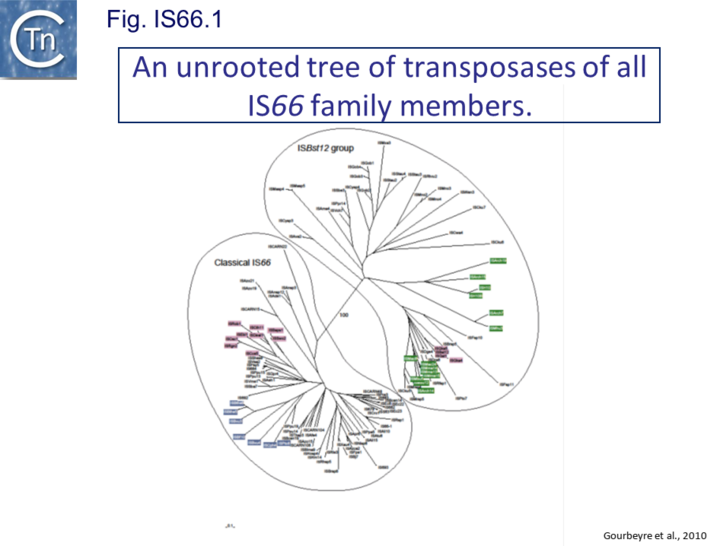
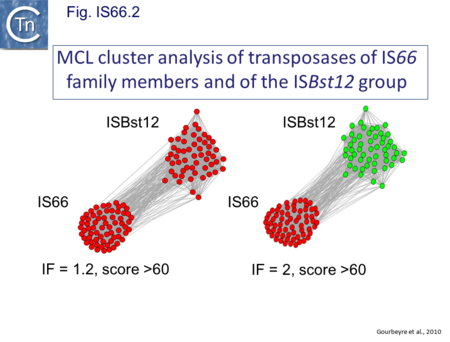
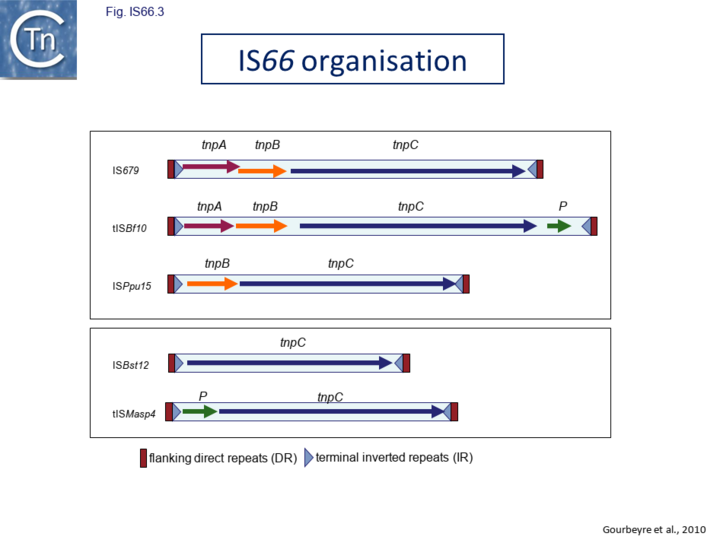
Genome Impact
Members of this family are involved in insertional gene inactivation (e.g. inactivation of the liaFSR operon leading to hypersensitivity to daptomycin[9]; loss of loss of S-layer-gene expression in Bacillus stearothermophilus [5]; gene disruption in the cyanobacterium Fremyella duplosiphon involved in regulation of phycoerythrin synthesis[10] and in the gnaA (encoding UDP-N-acetylglucosamine C-6 dehydrogenase) of Acinetobacter baumannii leading to changes in the antibacterial resistance profile[11]).
It has also been shown (using RACE) that IS66 insertion can create hybrid promoters[12].
Organization
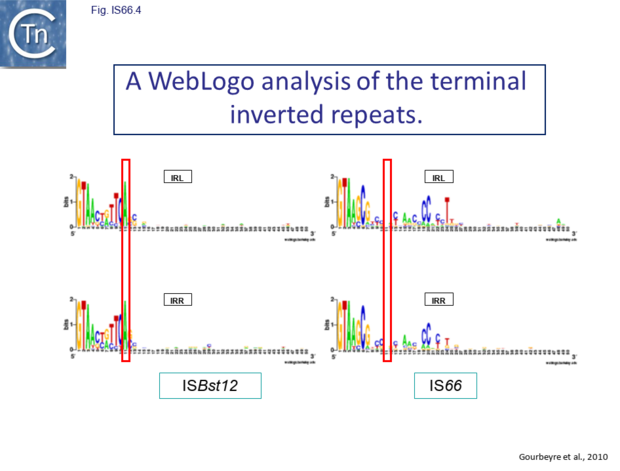
The IS66 reference copy from a plasmid of the enteropathogenic Escherichia coli B171, IS679[13] is defined by three orfs (Fig. IS66.3): tnpA, tnpB and tnpC and relatively well conserved terminal IR of about 20-30 bp flanked by an 8 bp DR at their insertion sites (Fig. IS66.4). Orf tnpC (Fig. IS66.5) is 1572 bp and its predicted product includes an N-terminal region with potential leucine zipper and zinc finger motifs (Fig. IS66.5; Fig. IS66.6a; Fig. IS66.7a) and a typical DDE motif (Fig. IS66.5; Fig. IS66.6b; Fig. IS66.7b; outlined in Fig. IS66.8). It also carries an insertion domain between the second D and the E of the DDE motif (e.g. IS679, ISPsy5 and ISMac8)[14] (see Fig.7.3) (Table Transposases examined by secondary structure prediction programs).
The role of the products of tnpA (651 bp) and tnpB (345 bp) is less clear. TnpA carries a potential HTH motif ((Fig. IS66.9) while TnpB shows no marked potential secondary structure motifs. Mutation of each orf separately (by introduction of an in-frame deletion) reduced transposition by at least two orders of magnitude [13]. The three frames are disposed in a pattern suggesting translational coupling: tnpB is in general in translational reading frame -1 compared to tnpA and in most cases the termination codon of tnpA and the initiation codon of tnpB overlap (ATGA). An initiation codon for tnpC occurs slightly downstream, separated from tnpB by about 20 bp.
However, rather surprisingly, in the light of a requirement for all three orfs for transposition of the canonical IS66 family member IS679, members of the ISBst12 group are devoid of tnpA and tnpB and carry only the tnpC reading frame. Although both ISBst12 and IS66 members contain IRs which start with 5’ GTAA 3’, they are clearly distinguishable due to a single conserved A at bp 11 In ISBst12 which is not conserved in IS66 (Fig. IS66.1; Fig. IS66.4).
IS66 members can be grouped into three classes based on their organization: those including all three orfs, A, B and C transcribed in the same direction; those with additional passenger genes invariably present downstream of orfC and transcribed in the same direction; and those which lack orfA but retain both orfs B and C (Fig. IS66.1; Fig. IS66.3). Each of these organizations includes members with multiple copies, implying that they are active in transposition. In addition to the DDE catalytic domain (Fig. IS66.5; Fig. IS66.6b; Fig. IS66.7b)[4], TnpC also exhibits a highly conserved CwAH-rR motif downstream of the second D residue, a relatively conserved CX2(C)X33CX2C motif characteristic of a zinc finger (ZF) further upstream and a leucine-rich region which might form a leucine zipper (LZ) necessary in multimerisation of other Tpases [15], at the N-terminus (Fig. IS66.5; Fig. IS66.6a; Fig. IS66.7a).
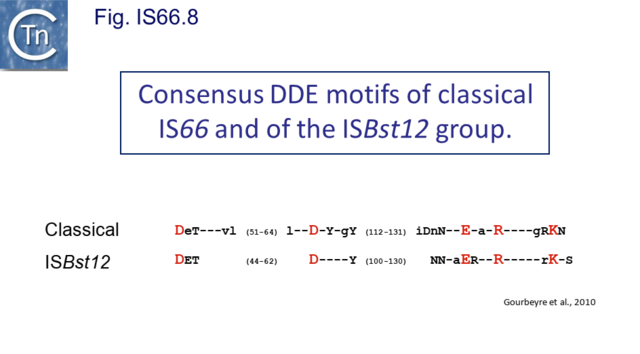
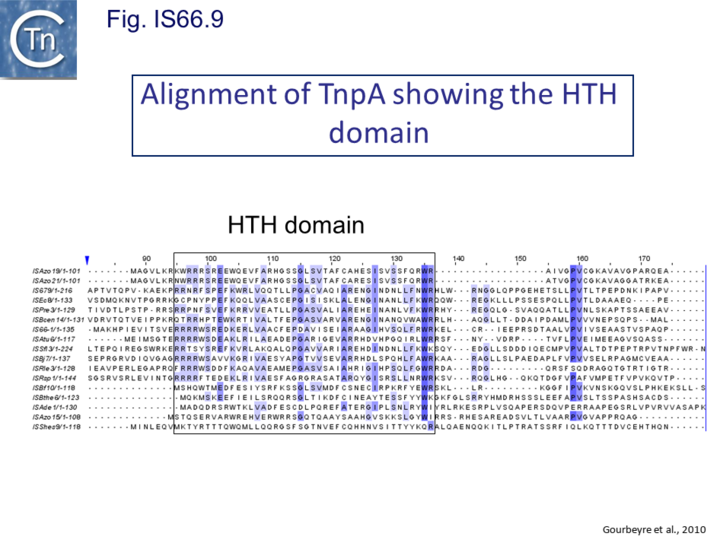
A list of representative IS66 family members and the ISBst12 group
| Table IS66.1. A list of representative IS66 family members and the ISBst12 group. The table summarises from left to right: the IS name; group defined in the MCL analysis; accession number; host from which it was identified; kingdom (archaea, A, or bacteria, B); phylum; organisation (org) A,B,C,P show the presence of TnpA, TnpB, TnpC and Passenger genes respectively; length of the IS in base pairs (bp); length of the terminal Inverted Repeats (IR); length of flanking Direct Repeats (DR); number of examples identified in the host genome. | ||||||||||
| IS Name | Group | Accession number | Host | A/B | G+/G- | Org. | L (bp) | IR (bp) | DR (bp) | N° |
|---|---|---|---|---|---|---|---|---|---|---|
| IS66-1 | — | AF242881 | Agrobacterium tumefaciens | B | G- | ABC | 2556 | 18/20 | 8 | 2 |
| IS679 | — | NC_002142 | Escherichia coli | B | G- | ABC | 2704 | 17/25 | 8 | 6 |
| ISAde1 | — | NC_011891 | Anaeromyxobacter dehalogenans 2CP-1 | B | G- | ABC | 2957 | 20/27 | 8 | 2 |
| ISAtu6 | — | NC_010929 | Agrobacterium tumefaciens | B | G- | ABCP | 2798 | 23/24 | 8 | 3 |
| ISAzo15 | — | NC_006513 | Azoarcus sp. EbN1 or Aromatoleum aromaticum EbN1 | B | G- | ABC | 2441 | 20/21 | 8 | 4 |
| ISAzo19 | — | NC_006513 | Azoarcus sp. EbN1 or Aromatoleum aromaticum EbN1 | B | G- | ABC | 2423 | 23/26 | 8 | 3 |
| ISAzo21 | — | NC_006513 | Azoarcus sp. EbN1 or Aromatoleum aromaticum EbN1 | B | G- | ABC | 2423 | 23/26 | 8 | 2 |
| ISBcen14 | — | NC_011001 | Burkholderia cenocepacia J2315 | B | G- | ABC | 2516 | 18/22 | 8 | 4 |
| ISBf10 | — | NC_006347 | Bacteroides fragilis YCH46 | B | G- | ABCP | 2939 | 20/21 | 8 | 4 |
| ISBj7 | — | NC_004463 | Bradyrhizobium japonicum USDA 110 | B | G- | ABC | 2865 | 40/50 | 8 | 2 |
| ISBthe6 | — | NC_004663 | Bacteroides thetaiotaomicron | B | G- | ABC | 2544 | 24 | 8 | 2 |
| ISBvu4 | — | NC_009614 | Bacteroides vulgatus ATCC 8482 | B | G- | BC | 2371 | 30/32 | 8 | 5 |
| ISEc8 | — | NC_004431 | Escherichia coli CFT073 | B | G- | ABC | 2442 | 18/22 | 8 | 7 |
| ISPpu15 | — | NC_002947 | Pseudomonas putida KT2440 | B | G- | BC | 2041 | 22/28 | 8 | 4 |
| ISPre3 | — | NC_004444 | Pseudomonas resinovorans | B | G- | ABCP | 2957 | 17/24 | 8 | 2 |
| ISPsy5 | — | AE016853 | Pseudomonas syringae pv. tomato str. DC3000 | B | G- | BC | 2059 | 21/28 | 8 | 33 |
| ISRle3 | — | NC_008382 | Rhizobium leguminosarum bv. viciae 3841 | B | G- | ABC | 2500 | 14/15 | 8 | 2 |
| ISRsp1 | — | U00090 | Rhizobium sp. NGR234 | B | G- | ABCP | 3481 | 17/22 | 8 | 2 |
| ISSfl3 | — | AL391753 | Shigella flexneri | B | G- | ABC | 2729 | 11 | 0 | 2 |
| ISShes9 | — | NC_008750 | Shewanella sp. W3-18-1 | B | G- | ABC | 2370 | 18/24 | 8 | 3 |
| ISAma4 | ISBst12 | NC_011138 | Alteromonas macleodii 'Deep ecotype' | B | G- | C | 1529 | 28/29 | 9 | 3 |
| ISAva2 | ISBst12 | NC_007410 | Anabaena variabilis ATCC 29413 | B | G- | C | 1547 | 14 | 8 | 9 |
| ISBrsp5 | ISBst12 | NC_009445 | Bradyrhizobium sp. ORS278 | B | G- | C | 1541 | 18/19 | 8 | 2 |
| ISBst12 | ISBst12 | AF162268 | Bacillus stearothermophilus | B | G+ | C | 1612 | 15/16 | 8 | 15 |
| ISCysp3 | ISBst12 | NZ_AAXW00000000 | Cyanothece sp. CCY 0110 | B | G- | C | 1522 | 14 | 8 | 18 |
| ISCysp4 | ISBst12 | NC_011884 | Cyanothece sp. PCC 7425 | B | G- | C | 1585 | 14/17 | 8 | 12 |
| ISDge4 | ISBst12 | NC_008025 | Deinococcus geothermalis DSM 11300 | B | G+ | C | 1453 | 18/25 | 8 | 6 |
| ISGka4 | ISBst12 | NC_006509 | Geobacillus kaustophilus HTA426 | B | G+ | C | 1635 | 21/24 | 8 | 3 |
| ISGob3 | ISBst12 | NZ_ABGO00000000 | Gemmata obscuriglobus UQM 2246 | B | G- | C | 1597 | 11/12 | 8 | 8 |
| ISGob4 | ISBst12 | NZ_ABGO00000000 | Gemmata obscuriglobus UQM 2246 | B | G- | C | 1576 | 14/15 | 8 | 6 |
| ISGst1 | ISBst12 | NC_010420 | Geobacillus stearothermophilus | B | G+ | C | 1613 | 18/26 | 8 | 3 |
| ISH10 | ISBst12 | NC_002607 | Halobacterium sp. NRC-1 | A | — | C | 1584 | 16/18 | 8 | 5 |
| ISMac8 | ISBst12 | NC_003552 | Methanosarcina acetivorans C2A | A | — | C | 1603 | 13/15 | 8 | 3 |
| ISMasp4 | ISBst12 | NC_008576 | Magnetococcus sp. MC-1 | B | G- | PC | 1969 | 19 | 8 | 7 |
| ISMbu5 | ISBst12 | NC_007955 | Methanococcoides burtonii DSM 6242 | A | — | C | 1696 | 18/19 | 8/0 | 9 |
| ISMhu3 | ISBst12 | NC_007796 | Methanospirillum hungatei JF-1 | A | — | PC | 1727 | 9/12 | 0 | 2 |
| ISMma14 | ISBst12 | NC_003901 | Methanosarcina mazei Go1 | A | — | C | 1529 | 22/30 | 8 | 9 |
| ISMno2 | ISBst12 | NC_011894 | Methylobacterium nodulans ORS 2060 | B | G- | C | 1419 | 21/27 | 8 | 8 |
| ISPpr14 | ISBst12 | NC_006371 | Photobacterium profundum SS9 | B | G- | C | 1568 | 19/27 | 8/9 | 9 |
| ISWen3 | ISBst12 | NZ_AAGB00000000 | Wolbachia endosymbiont of Drosophila ananassae | B | G- | C | 1482 | 18/20 | 8-0 | 30 |
Mechanism and Insertion Specificity
Nothing is known about the transposition mechanism of this group of IS and they exhibit no substantial target sequence specificity.
Bibliography
- ↑ <pubmed>6095299</pubmed>
- ↑ <pubmed>6366736</pubmed>
- ↑ <pubmed>24302303</pubmed>
- ↑ 4.0 4.1 </nowiki>
- ↑ 5.0 5.1 Egelseer EM, Idris R, Jarosch M, Danhorn T, Sleytr UB, Sára M . ISBst12, a novel type of insertion-sequence element causing loss of S-layer-gene expression in Bacillus stearothermophilus ATCC 12980. - Microbiology (Reading): 2000 Sep, 146 ( Pt 9);2175-2183 [PubMed:10974105] [DOI] </nowiki>
- ↑ <pubmed>29712655</pubmed>
- ↑ <pubmed>1633570</pubmed>
- ↑ <pubmed>18792942</pubmed>
- ↑ <pubmed>27353469</pubmed>
- ↑ <pubmed>21888899</pubmed>
- ↑ <pubmed>31358579</pubmed>
- ↑ <pubmed>29374029</pubmed>
- ↑ 13.0 13.1 Han CG, Shiga Y, Tobe T, Sasakawa C, Ohtsubo E . Structural and functional characterization of IS679 and IS66-family elements. - J Bacteriol: 2001 Jul, 183(14);4296-304 [PubMed:11418571] [DOI] </nowiki>
- ↑ <pubmed>20067338</pubmed>
- ↑ <pubmed>9761671</pubmed>
